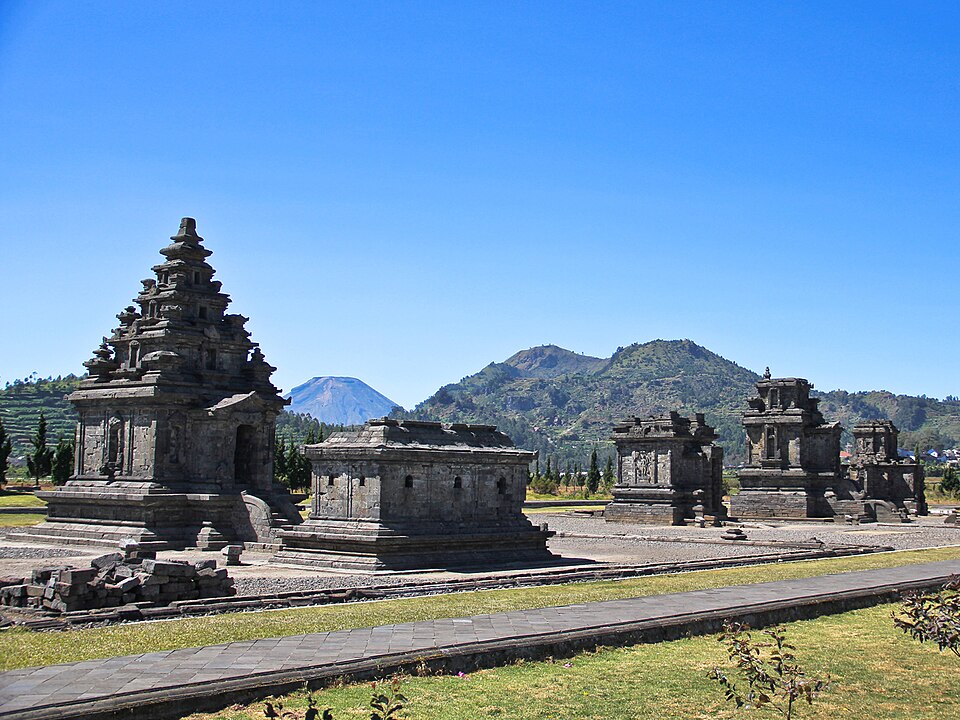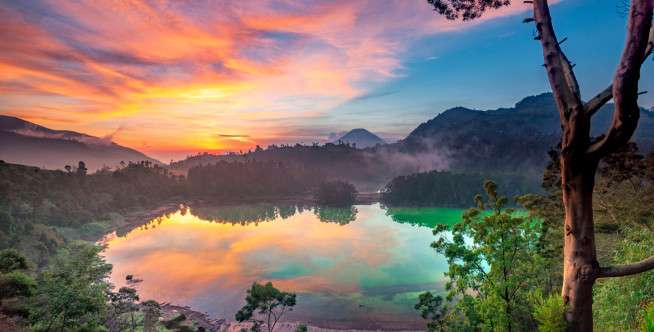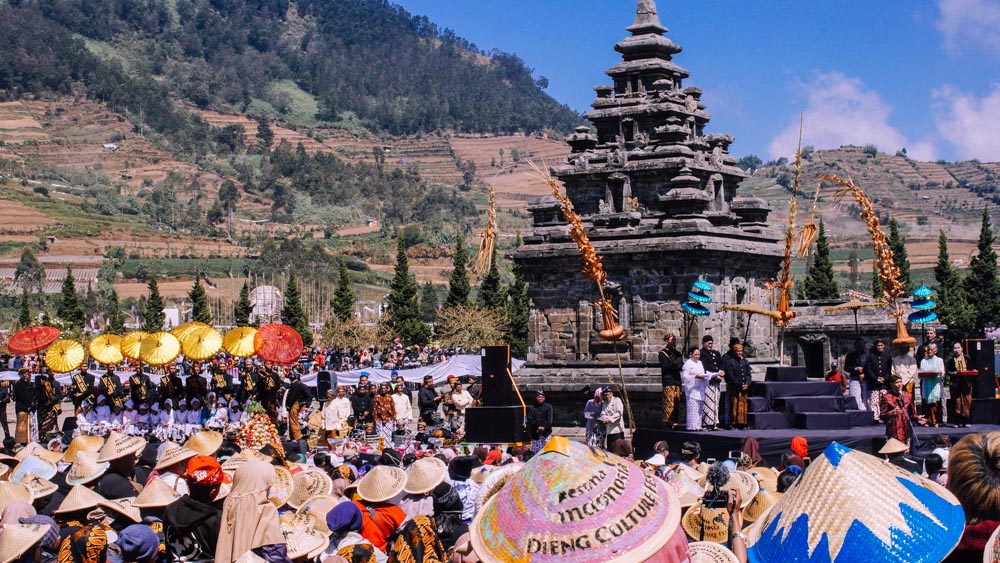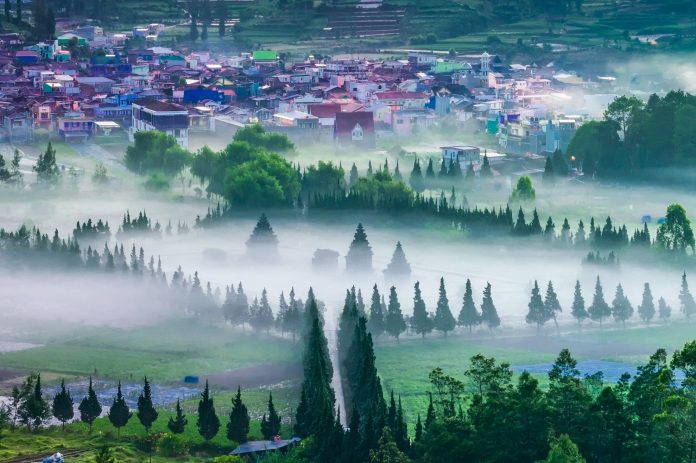A Trip to Dieng Plateau Among Mist and Myth
High in the mountains of Central Java, where clouds curl through ancient volcanic craters and sulphur mists rise from turquoise lakes, lies the Dieng Plateau—a mystical highland that has captivated pilgrims, poets, and geologists alike for over a millennium. At 2,000 metres above sea level, this caldera plateau is more than just a destination. It is a place where Indonesia’s natural wonders and deep spiritual heritage converge in an otherworldly harmony.
A Name from the Heavens
The name Dieng is believed to be derived from the Old Javanese words di hyang, meaning abode of the gods. This is no exaggeration. With its cool alpine climate, bubbling geothermal features, and hauntingly beautiful landscape, the Dieng Plateau feels suspended between Earth and sky—a liminal zone shaped by ancient volcanic fury and the slow patience of history.
A Cradle of Ancient Javanese Civilization
Dieng is home to some of the oldest Hindu temples in Java, dating back to the 8th and 9th centuries during the Sanjaya Dynasty. These small, squat temples, built in honor of Shiva and other deities, are scattered across the plateau like sacred ruins, worn but enduring—silent witnesses to the spread of Hinduism from India through the Indonesian archipelago.
 The Arjuna Temple complex is the most accessible and best preserved. Built from volcanic andesite stone, the temples rise like dark sentinels against the misty backdrop of Mount Prau. Archaeological evidence suggests the plateau was once a religious center—possibly the highest place of worship in ancient Java, accessible only to the spiritual elite.
The Arjuna Temple complex is the most accessible and best preserved. Built from volcanic andesite stone, the temples rise like dark sentinels against the misty backdrop of Mount Prau. Archaeological evidence suggests the plateau was once a religious center—possibly the highest place of worship in ancient Java, accessible only to the spiritual elite.
Geothermal Marvels and Otherworldly Landscapes
Beyond its spiritual allure, Dieng is a geologist’s dream. The plateau is part of a vast collapsed caldera, and its geothermal activity is constantly reshaping the terrain. One of the most striking features is Kawah Sikidang, a bubbling mud crater that shifts location every few years. The acrid scent of sulphur and the hissing steam rising from the earth add a primordial energy to the landscape.
Equally breathtaking is Telaga Warna, or the “Color-Changing Lake.” Depending on the light and the levels of sulphuric compounds, its waters shift from emerald green to aquamarine to deep sapphire—an enchanting palette that locals believe is tied to supernatural forces.

Culture and Ritual in the Clouds
The Dieng Plateau is not just a geological or historical marvel—it is also alive with ritual and folklore. The annual Dieng Culture Festival draws thousands of visitors who come to witness traditional arts, jazz concerts under the stars, and the ritual shaving of dreadlocked children, or anak gimbal. These children are believed to be chosen by the spirits, and their hair is cut only after elaborate ceremonies to ensure blessings and protection.

Local life remains deeply intertwined with ancient beliefs. Farmers grow potatoes, carica (a highland papaya), and cabbages on terraced fields that mirror Bali’s subak systems. Villages are cloaked in mist, and myths are part of everyday conversation—tales of unseen guardians, sacred wells, and ancestral curses are taken seriously.
How to Get There
Dieng Plateau is best accessed via Wonosobo, a pleasant mountain town around 3–4 hours from Yogyakarta or Semarang by car. From Wonosobo, the winding road up to Dieng offers dramatic views of tea plantations, steep ridges, and the twin volcanoes of Sindoro and Sumbing.
When to Visit
The dry season, from May to September, is ideal, with the clearest skies for sunrise hikes and sightseeing. July–August is festival season, but also the most crowded. Temperatures can drop to near freezing at night, especially in the dry season—pack layers. Sunrise at Bukit Sikunir, overlooking the twin volcanoes Sindoro and Sumbing, is a highlight—though you’ll need to brave the pre-dawn chill.
Getting There
The nearest transit hub is Wonosobo, accessible by car or bus from Yogyakarta (4–5 hours) or Semarang (3–4 hours). From Wonosobo, local transport or a rented vehicle will take you up the winding mountain road to Dieng.
Is Dieng Suitable for Young Children or Toddlers?
While it’s possible to bring toddlers, it may not be ideal due to the altitude, cold temperatures, and basic facilities. The uneven terrain is not stroller-friendly, and volcanic fumes might be too strong for younger children. If traveling with infants, a carrier is essential, and extra care should be taken.
- Dieng is cold—especially at night or early in the morning. Pack appropriately
- Winding Roads and Long Travel Times. Getting to Dieng involves a 3–5 hour drive from Yogyakarta or Semarang, with the last leg being a narrow, winding mountain road. Kids prone to motion sickness might find the journey uncomfortable.
- Volcanic Fumes. The sulfuric fumes at Kawah Sikidang can be intense. While older children often find it thrilling, kids with asthma or respiratory sensitivities may struggle.
- Basic Accommodations. Most places to stay in Dieng are modest homestays with simple facilities and no heating.
Dieng Plateau is not your typical family vacation spot—but that’s exactly what makes it so special. For children with a spirit of curiosity and parents who enjoy nature and culture, it’s a rewarding, eye-opening experience.
With the right clothing, pacing, and safety awareness, Dieng becomes more than a destination—it’s a highland classroom, a photo album of wonder, and a memory that will stay with your family long after the mist has cleared.
Travel Tips
- Stay overnight: While many visit on day trips, staying in Dieng allows you to witness the mystical sunrise from Bukit Sikunir and enjoy the silence after the day-trippers depart.
- Dress warmly: Temperatures range between 10–20°C, and it can get colder at dawn.
- Respect local customs: Dieng is a deeply spiritual place for locals. Dress modestly and be mindful when photographing people or ceremonies.






